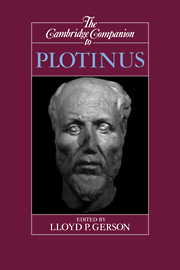Book contents
- Frontmatter
- Introduction
- 1 Plotinus
- 2 Plotinus's metaphysics of the One
- 3 The hierarchical ordering of reality in Plotinus
- 4 On soul and intellect
- 5 Essence and existence in the Enneads
- 6 Plotinus on the nature of physical reality
- 7 Plotinus on matter and evil
- 8 Eternity and time
- 9 Cognition and its object
- 10 Self-knowledge and subjectivity in the Enneads
- 11 Plotinus
- 12 Human freedom in the thought of Plotinus
- 13 An ethic for the late antique sage
- 14 Plotinus and language
- 15 Plotinus and later Platonic philosophers on the causality of the First Principle
- 16 Plotinus and Christian philosophy
- Bibliography
- Index
3 - The hierarchical ordering of reality in Plotinus
Published online by Cambridge University Press: 28 May 2006
- Frontmatter
- Introduction
- 1 Plotinus
- 2 Plotinus's metaphysics of the One
- 3 The hierarchical ordering of reality in Plotinus
- 4 On soul and intellect
- 5 Essence and existence in the Enneads
- 6 Plotinus on the nature of physical reality
- 7 Plotinus on matter and evil
- 8 Eternity and time
- 9 Cognition and its object
- 10 Self-knowledge and subjectivity in the Enneads
- 11 Plotinus
- 12 Human freedom in the thought of Plotinus
- 13 An ethic for the late antique sage
- 14 Plotinus and language
- 15 Plotinus and later Platonic philosophers on the causality of the First Principle
- 16 Plotinus and Christian philosophy
- Bibliography
- Index
Summary
Never use the words higher and lower.
Charles DarwinIf we have any preconceptions about Plotinus, before looking at him more closely, these preconceptions are likely to include the notion that his world is a “hierarchy,” or “chain of being” stretching from some mysterious transcendent cause, the One, down through a succession of levels to the bottom level, matter. This notion, derived from the doxographic surveys to be read in our manuals of the history of philosophy, influenced also perhaps by our ideas of later ancient and medieval philosophical systems, is likely to strike us as strange and constitute a major obstacle to wishing or being able to understand Plotinus better. For such a hierarchical world-view will be felt to be anachronistic and unacceptable if we stay within the implicit metaphysical materialism of our time, if we adhere to vague social and political feelings about equality, if we find that talk of “degrees of being” is philosophical nonsense, if we insist that it is we who make our (different) world-views.
If nonetheless we try to come to terms with Plotinus's hierarchical world-view, we soon meet with difficulty of another kind. The term “hierarchy” was first coined in the early sixth century a.d. by a Christian author much influenced by the later Neoplatonism of Proclus, Pseudo-Dionysius. The term is not found in Plotinus, nor are other expressions (in particular 'chain of being') sometimes used today to refer to Plotinus's view of reality.
- Type
- Chapter
- Information
- The Cambridge Companion to Plotinus , pp. 66 - 81Publisher: Cambridge University PressPrint publication year: 1996
- 11
- Cited by



